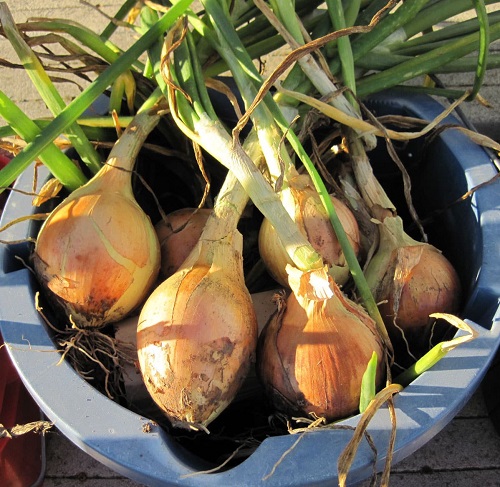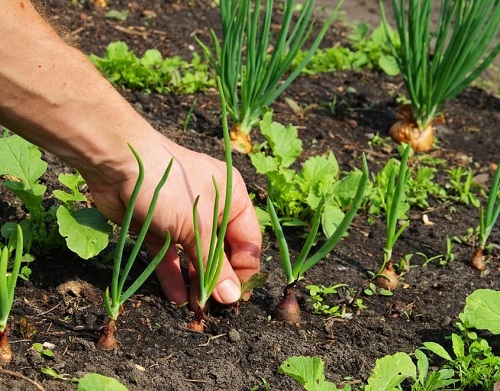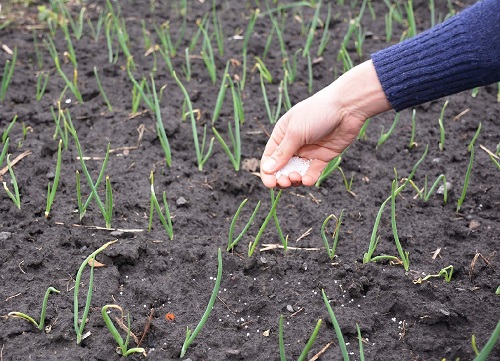Follow our professional Tips and Tricks for Growing Bigger Onions in this informative guide to grow the best ones at home!
If you are looking forward to Growing Bigger Onions at home, then these tips and tricks are all you need!
Learn Everything About Growing Onions In Pots here
Tips and Tricks for Growing Bigger Onions
1. Choose the Right Onion Variety
Choosing the right onion variety for your climate can help ensure that your onions grow to their full potential.
- Kelsae Sweet Onion: This is one of the largest onion varieties, often weighing in at over 2 kilograms (5 pounds) each. The Kelsae Sweet Onion has a mild flavor and is popular for its large size and crisp texture.
- Ailsa Craig Onion: This variety can grow up to 1 kilogram (2.2 pounds) each and has a sweet, mild flavor. The Ailsa Craig Onion is popular for its large size and is often used for exhibition and competition purposes.
- Stuttgarter Onion: The Stuttgarter Onion is a popular variety in Europe and can grow up to 500 grams (1.1 pounds) each. It has a pungent flavor and is often used in cooking.
- Walla Walla Onion: This variety is grown in the Pacific Northwest region of the United States and can grow up to 450 grams (1 pound) each. The Walla Walla Onion has a sweet, mild flavor and is often eaten raw in salads.
- Spanish Onion: This onion variety can grow up to 350 grams (12 ounces) each and has a mild, sweet flavor. The Spanish Onion is often used in cooking and is a popular ingredient in soups, stews, and sauces.
Check out Ornamental Onion Types here
2. Plant at the Right Time
The right time to plant onions depends on the climate and growing conditions in your area. In general, onions are cool-season crops that prefer cool temperatures during the early stages of growth and warmer temperatures during bulb formation.
Onions are typically planted in the fall or early spring, depending on your location. In areas with mild winters, onions can be planted in the fall and overwintered to produce larger bulbs in the spring. In colder areas, onions can be planted in early spring as soon as the soil can be worked.
Check out our article on growing green onions in pots all year here!
3. Use the Right Growing Medium
Onions grow best in loose, well-draining soil that is rich in organic matter. Avoid heavy clay soils that can become compacted and waterlogged, as this can stunt onion growth and cause bulbs to rot. Add organic matter, such as compost or aged manure, to improve soil texture and drainage.
Onions prefer slightly acidic to neutral soil with a pH between 6.0 and 7.0. If the soil is too acidic, add lime to raise the pH. If the soil is too alkaline, add sulfur to lower the pH.
Learn How to Check Your Soil pH at Home here
4. Spacing is the Key
Spacing is an important factor in growing big onion bulbs. Here are some tips on how to space onion plants to ensure they grow bigger in size:
Onions should be spaced about 10-15 cm (4-6 inches) apart, depending on the variety. Crowded onions will produce smaller bulbs, so it is important to give them enough space to grow.
Rows of onions should be spaced about 30-45 cm (12-18 inches) apart, depending on the size of the plants and the equipment being used to cultivate the soil.
By spacing onion plants properly, you can help ensure that they have enough room to grow and produce big, healthy bulbs. Avoid overcrowding and provide enough space for the plants to develop a strong root system and access to nutrients and water.
Here are the best ways to water plants
5. Maintain the Right Level of Moisture
Watering is an important aspect of growing big onions. Onions require consistent moisture during the growing season. Keep the soil evenly moist but not waterlogged throughout the season. Inconsistent watering can result in smaller bulbs and may cause onions to bolt or go to seed prematurely.
Water onion plants deeply and infrequently to encourage deep root growth. This helps the plants access water and nutrients from the lower layers of soil. Use a soaker hose or drip irrigation system to water the plants slowly and evenly, rather than overhead sprinklers that can wet the foliage and promote fungal diseases.
Water onion plants early in the morning or in the evening to reduce water loss through evaporation. Avoid watering during the hottest part of the day when the sun is strongest, as this can cause water to evaporate before it has a chance to penetrate the soil.
Monitor soil moisture regularly by checking the top few inches of soil. If the soil feels dry to the touch, it’s time to water. Avoid overwatering, as this can cause bulbs to rot and reduce yield.
Here are Signs of Overwatering & How to Save an Overwatered Plant
6. Feed Regularly
Before planting onions, amend the soil with compost, aged manure, or other organic matter to improve soil fertility and structure. Apply a balanced fertilizer, such as 10-10-10 or 8-8-8, once in 4-5 weeks for best results. Do refer to the package for dosage and instructions.
Side-dress onions with fish emulsion or blood meal when the plants are about 15 cm (6 inches) tall and again when the bulbs begin to form. You can also use compost tea once a month, as it is a natural and organic way to provide nutrients to onions. It provides a slow release of nutrients and also helps improve soil structure and microbial activity.
Want to Make Organic Fertilizers from Kitchen Scraps? Click here
7. Get Rid of Pests and Diseases
- Use Crop Rotation: Onions should be rotated with other crops to reduce the risk of soil-borne diseases. Avoid planting onions in the same spot for more than two years in a row.
- Proper Spacing: Proper spacing is important to prevent the spread of diseases and pests. Avoid overcrowding onions and provide enough space for air circulation.
- Insect Control: Use insecticides or organic pest control methods to prevent damage from pests, such as onion maggots or thrips. Apply insecticides according to the package instructions and use organic methods, such as companion planting or row covers, to deter pests.
- Fungus Control: Use fungicides or organic methods to prevent fungal diseases, such as leaf spot or bulb rot. Apply fungicides according to the package instructions and use organic methods, such as proper watering and drainage, to prevent the growth of fungal spores.
- Remove Infected Plants: Remove infected plants and plant debris promptly to prevent the spread of diseases. Do not compost infected plant material, as this can spread the disease to other areas.
Check out Our Article on Getting Rid of Pests Naturally here!
8. Harvest At the Correct Time

Harvesting onions at the right time is important to ensure that they reach their maximum size.
- Observe the Foliage: As onions mature, the foliage will start to turn yellow and wilt. This is a sign that the onions are almost ready for harvest.
- Check the Bulb Size: Onions reach their maximum size about 90-100 days after planting. Check the size of the bulbs by gently digging around the base of the plants. If the bulbs are still small, wait a few more weeks before harvesting.
- Bend the Foliage: About a week before harvesting, bend the foliage down to the ground. This will help the bulbs dry out and increase the size of the neck.
- Stop Watering: Stop watering the onions about a week before harvesting to help the necks dry out and prevent rot.








